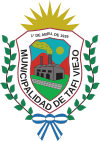Tafí Viejo, Tucumán facts for kids
Quick facts for kids
Tafí Viejo
|
||
|---|---|---|
|
||
| Country | ||
| Province | ||
| Department | Tafí Viejo | |
| Established | May 3, 1900 | |
| Elevation | 591 m (1,939 ft) | |
| Population
(2010 census)
|
||
| • Total | 39,601 | |
| Demonym(s) | taficeño/a | |
| Time zone | UTC-3 (ART) | |
| CPA base |
T4103
|
|
| Dialing code | +54 0381 | |
| Website | Official website: http://www.tafiviejoesmiciudad.com.ar | |
Tafí Viejo is a town in Argentina, located in the Province of Tucumán. In 2001, about 48,459 people lived there. Tafí Viejo is about 15 kilometers (9 miles) north of San Miguel de Tucumán. It is now an important part of the larger city's metro area.
Contents
About Tafí Viejo
Tafí Viejo is about 600 meters (2,000 feet) above sea level. It sits at the base of the Aconquija Mountains. The first people to live here spoke the Aymara language. They named the place with a word that means "where the cold winds blow."
Early History and the Railway
In 1882, the Northern Central Railway arrived. This made Tafí Viejo a popular spot for people from San Miguel de Tucumán to visit on weekends. On May 3, 1900, the town was officially started and called San José de Calasanz.
In 1904, Tafí Viejo was chosen for one of Argentina's biggest railway equipment factories. This factory opened in May 1910.
Growth and Challenges
The growing town was renamed Tafí Viejo on June 2, 1939. In 1948, President Juan Perón made the railways state-owned. The factory was updated and made bigger. By the 1950s, over 5,600 people worked there. They built many freight cars, passenger cars, and steam locomotives every month.
Later, a military government closed the factory in 1980. This caused big economic problems for Tafí Viejo. Many people lost their jobs.
Reopening and Modern Times
President Raúl Alfonsín reopened the factory in 1984. However, it could not get back its role as the town's main employer. In 1996, Governor Antonio Domingo Bussi closed it again.
Finally, President Néstor Kirchner reopened the factory in 2003. Tafí Viejo continues to grow, even after these challenges.
The town has also developed good services and tourism. People from the metro area visit on weekends. Now, more people are coming to the Alpa-Puyo resort. It has cabins, guided tours, and a small zoo.
Images for kids
See also
 In Spanish: Tafí Viejo para niños
In Spanish: Tafí Viejo para niños







